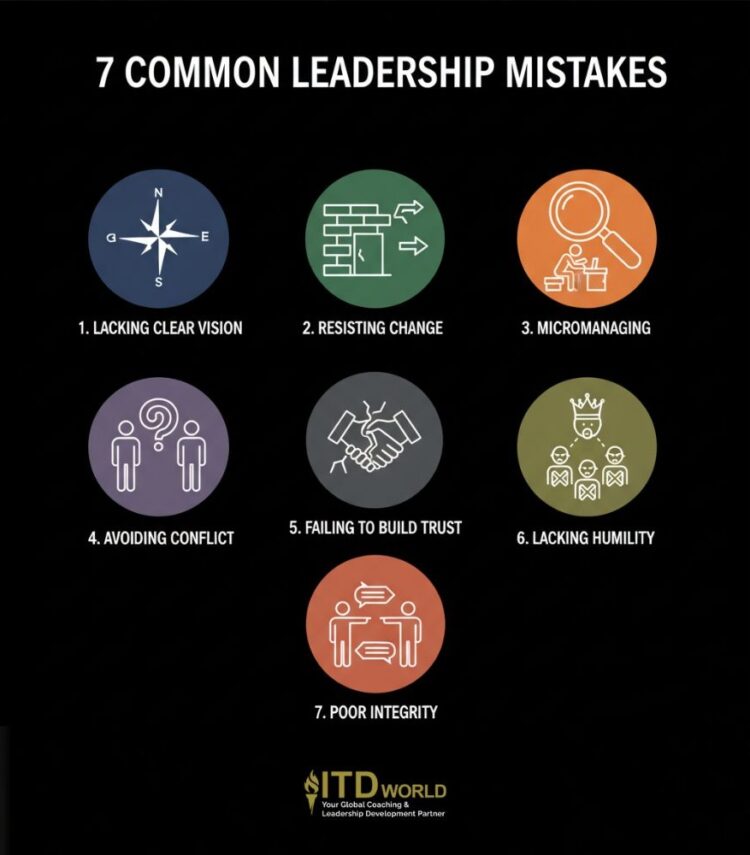Discover a list of common leadership mistakes, plus a practical framework for turning missteps into opportunities for growth.
Leadership is a journey, not a destination; even the most seasoned travelers can occasionally take a wrong turn. While striving for perfection is admirable, the reality is that all leaders will make mistakes. The defining quality of great leadership, therefore, is not the absence of error, but the response to it. Whether one is able to recognize, own, correct, and learn from missteps is what separates truly effective leaders from those who simply hold the title.
|
Author: Jonathan M. Pham |
Highlights
- Leadership mistakes, ranging from interpersonal errors that erode team trust and engagement to strategic missteps that can bankrupt entire companies, create a powerful ripple effect with devastating and costly consequences for an organization’s morale, productivity, and long-term success.
- Common leadership mistakes fall into three categories – strategy and vision, team management, and personal leadership; they can be solved through intentional strategic thinking, effective communication, delegation, conflict resolution, trust-building, humility, and integrity.
- Effective leaders navigate errors by promptly acknowledging them, offering sincere apologies for their impact, taking immediate action to rectify the situation, and amending their approach based on lessons learned, thereby fostering a culture of psychological safety and continuous improvement.
Why Leadership Mistakes Matter
A leader’s actions, both positive and negative, are never made in a vacuum. They create a powerful ripple effect that extends throughout their team and the entire organization, influencing everything from daily morale to long-term strategic success. While small errors may be corrected, a pattern of poor leadership or a single, significant strategic mistake is likely to cause devastating and costly consequences.
The ripple effect of a leader’s error
A leader’s missteps can quickly erode the psychological safety and trust essential for building high performance teams. It typically leads to a cascade of negative outcomes:
- Decreased engagement and productivity
Poor leadership is a primary driver of disengagement. According to Gallup, companies with low employee engagement scores suffer from lower productivity, lower profitability, and higher absenteeism. When leaders fail to provide clear direction, communicate effectively, or recognize contributions, team members are likely to become disconnected – and their performance drops as a result.
- Increased turnover
The old adage, “People don’t leave companies, they leave managers,” is consistently supported by data. Research has shown that a bad manager is one of the top reasons employees resign. The cost of this turnover – including recruitment expenses, training for new hires, and lost productivity – represents a significant and often preventable financial drain on the organization.
The mistakes that can break a company
While interpersonal mistakes damage teams, strategic ones may prove fatal to the entire enterprise. The business landscape is littered with examples of once-dominant companies that failed not because of a single market shift, but due to a fundamental failure of the management to see and act on the future.
A classic case study is Blockbuster’s failure to adapt to digital streaming. While commonly cited as a technology failure, it was, at its core, a leadership mistake. In 2000, Blockbuster’s leadership had the opportunity to buy a fledgling company named Netflix for $50 million. They declined, reportedly viewing it as a “very small niche business.” This lack of strategic foresight and an inability to embrace a new business model was a colossal error that ultimately led to the company’s bankruptcy – a powerful reminder that sometimes, the most expensive mistake a leader can make is one of inaction and a failure of vision.
Understanding these consequences – from daily team disengagement to existential business threats – makes it clear that developing leaders capable of avoiding and learning from missteps is not just good practice; it is essential for organizational survival and long-term success.

Leadership mistakes in the workplace
Read more: How to Build a Lasting Leadership Legacy
7 Common Leadership Mistakes & Their Solutions
Many of the common leadership mistakes are not unique; in fact, they tend to fall into predictable patterns and can, overall, be grouped into three key categories.
Mistakes in strategy & vision
These are high-level errors that occur at the very top. They set the entire team or organization on the wrong course; as such, their consequences can be far-reaching and difficult to correct.
-
Lacking a clear and compelling vision
In other words, it is the failure to define and articulate a clear, inspiring picture of the future. The leader may be an excellent day-to-day operator, but the team lacks a “North Star.” They understand what they are doing, but not why it matters in the grand scheme of things.
Consequences: Without a shared vision, teams work in silos on tasks that may not align with strategic priorities. Effort is duplicated, motivation wanes, and individuals feel disconnected from a larger purpose, leading to confusion and wasted resources.
Solution: A leader must intentionally carve out time for strategic thinking, stepping away from daily fire-fighting to reflect on the future of the market and the organization. Once developed, they must communicate the vision relentlessly – in all-hands meetings, in one-on-ones, and in written communication – until everyone understands the destination and their role in getting there.
Read more: Leadership Self-reflection – Key to Clarity & Long-term Success
-
Resisting necessary change
Many people suffer from the tendency to cling to the “way we’ve always done things,” even in the face of clear evidence that the market, technology, or customer expectations have shifted. It is the failure to adapt, typically driven by a fear of the unknown or an over-reliance on past successes.
Consequence: The organization becomes stagnant, loses its competitive edge, and gradually becomes irrelevant. As seen with the cautionary tales of companies like Blockbuster, this strategic mistake can ultimately be fatal.
Solution: The antidote to change resistance is to cultivate a growth mindset – one that views challenges as opportunities to learn and evolve, and actively fights confirmation bias by seeking out diverse perspectives. Effective leaders surround themselves with people who will question their assumptions, bring new ideas to the table, and help them see the future with clear eyes.
Read more: Change Management – How to Champion It
Mistakes in team management
These are the common, day-to-day deeds that erode trust, stifle individual growth, and are often the primary leadership mistakes that push a team to burnout.
-
Micromanaging the team
The irresistible urge to excessively control or monitor the work of subordinates is a common mistake for new leaders. It is caused by one’s own insecurity, a lack of trust in their followers’ capabilities, or the misguided belief that “if you want something done right, you have to do it yourself.”
Consequence: Micromanagement is toxic to autonomy and morale. It signals a deep lack of trust, discourages creative problem-solving, and creates a culture of dependency where team members are afraid to make a move without approval. Over time, it leads to disengagement and drives your most capable employees away.
Solution: The key is to learn to delegate outcomes, not tasks. For instance, instead of dictating every step of a presentation (“First, create this chart, then write this summary…”), an effective leader defines the desired outcome (“We need a compelling presentation that clearly shows our Q2 performance to the executive team by Friday”). They then let their team determine the “how,” offering support and resources as needed.
Read more: Mistakes Leaders Make When Giving Feedback
-
Avoiding conflict
This refers to the common tendency to shy away from uncomfortable but necessary conversations – which may manifest as tolerating a team member’s chronic underperformance, ignoring simmering tension between colleagues, or failing to give constructive criticism for fear of hurting someone’s feelings.
Consequence: Inevitably, it creates a culture of “artificial harmony” where mediocrity is accepted and problems fester under the surface. Your top performers become frustrated as they see underperformance go unaddressed, and small issues eventually snowball into major crises.
Solution: First, leaders must reframe their mindset: view healthy conflict not as a battle, but as a collaborative search for the best possible solution. Second, it is recommended that they learn to utilize structured feedback models to depersonalize the conversation.
Example: A simple framework like the Situation-Behavior-Impact (SBI) model enables one to deliver feedback that is objective and focused on facts (“In yesterday’s client meeting [Situation], you interrupted the client twice [Behavior], which made it appear that we weren’t listening to their concerns [Impact]”), rather than subjective and confrontational.
Read more: Emotional Intelligence in Leadership – How to Lead with Heart
-
Failing to build trust
A foundational error, it usually manifests in several toxic behaviors: communicating poorly or inconsistently, taking credit for the team’s successes, and passing the buck or blaming others for failures.
Consequence: Failure to promote trust is the fastest way to destroy psychological safety and breed a toxic culture. When leaders act in a self-serving manner, employees learn to focus on self-preservation and covering their backs rather than collaborating and taking risks. Innovation dies, and teamwork evaporates.
Solution: A leader must intentionally and consistently practice the opposite behaviors – i.e. communicating transparently, even when the news is bad; giving credit freely and publicly to those responsible for successes; and, most importantly, taking ultimate responsibility when things go wrong. Shielding the team from blame is a powerful act that builds unwavering loyalty.
Read more: Human Leadership in a Digital World
Mistakes in personal leadership
Perhaps the greatest leadership mistakes are not tactical, but personal. These are the errors in a leader’s own character and self-management that undermine their credibility, authority, and the trust placed in them. No matter how brilliant one’s strategy is, the following misdeeds make it difficult for anyone to follow them with genuine commitment.
-
Lacking humility
This is the “smartest person in the room” syndrome – the belief that the leader has all the answers and that their perspective is the only one that matters. It manifests as dismissing input from the team, reacting defensively to criticism, and rarely, if ever, admitting fault.
Consequence: The lack of humility creates enormous blind spots, making one shielded from the ground-level truth of their organization. It stifles innovation because team members learn that offering new ideas is futile. Ultimately, it fosters resentment, alienates top talent, and erodes respect for the leader’s authority.
Solution: It is vital that one consistently seeks out feedback by genuinely asking questions like, “What could I be doing better?” or “What am I not seeing?” Additionally, one needs to be the first to admit, “I don’t know” or “I was wrong,” so as to demonstrate vulnerability and cultivate a safe environment for others to be honest as well.
Read more: Leadership Feedback – Key to Changing for the Better
-
Failing to maintain integrity
In other words, it is about the critical failure to align actions with words – when one makes promises that are not kept, espouses company values while personally violating them, or creates rules for the team that the leader does not follow themselves.
Consequence: When a “say-do” gap exists, the leader’s words become meaningless, and a culture of cynicism spreads throughout the team. It signals that hypocrisy is acceptable – and that the stated values of the organization are just empty slogans.
Solution: The solution requires constant self-discipline: ensure your actions are your most important message. For example, if a leader preaches the importance of work-life balance/ workplace wellbeing but consistently sends emails at 10 PM on a Saturday, their words are completely undermined. Having integrity requires one to protect their team’s time and their own, demonstrating the stated value through actions, not just speeches.
Read more: Leadership Branding – Crafting an Inspiring Personal Identity

New leadership mistakes
How to Handle Mistakes as a Leader: A 4-Step Recovery Framework
In the modern workplace, the old-fashioned belief that those in management positions must appear infallible is a liability. On the other hand, being willing to admit when one is wrong demonstrates authenticity and trustworthiness; it signals to others that they are encouraged to take smart risks, admit when they need help, learn from their own failures without fear of blame, and focus on finding solutions instead of wasting energy on assigning blame.
When you realize an error has been made, the following framework may come in handy:
- Acknowledge: State the mistake clearly, promptly, and without excuses. Take direct ownership of your role in the situation.
Example: “I realize that the deadline I set for the Q3 report was unrealistic and did not account for the team’s existing workload.”
- Apologize: Express sincere and specific regret for the impact your action had on your team or the organization. A simple, direct apology is always most effective.
Example: “I sincerely apologize for the stress and long hours this has caused all of you over the past two weeks.”
- Act: Communicate the immediate steps you are taking to fix the problem or mitigate the damage – so as to show that you are taking action, not just talking.
Example: “To address this right now, I am officially extending the deadline by one week and am re-prioritizing two other tasks to free up your capacity.”
- Amend: Explain what you have learned from the experience, as well as what systemic or behavioral change you will make to prevent it from happening again.
Example: “Moving forward, I will involve the team in the timeline-setting process for all major projects to ensure our goals are both ambitious and achievable. I have learned a valuable lesson about making assumptions.”
Ultimately, the most effective leaders go beyond just recovering from mistakes; they reframe their relationship with failure entirely. They view errors not as blemishes on their record, but as data points – powerful information about what to do differently next time.
A leader who consistently models such a mindset – learning from failure, adapting their approach, and growing stronger from the experience – contributes to a resilient and innovative culture where the entire team feels empowered to do the same.
Read more: Leadership Excellence – Moving From Manager to Multiplier

Leadership Mistakes Quotes
Check out more leadership quotes here!
All leaders make mistakes. They are a part of life. Successful leaders recognize their errors, learn from them, and work to correct their faults.
Superior leaders are willing to admit a mistake and cut their losses. Be willing to admit that you’ve changed your mind. Don’t persist when the original decision turns out to be a poor one.
The biggest leadership failures come from forgetting to remain human.
Margaret Thatcher
Leadership without humility is like wealth without wisdom.
Unknown
The only real mistake is the one from which we learn nothing.
Henry Ford
Nothing will kill a great employee faster than watching you tolerate a bad one.
Perry Belcher
People follow leaders by choice. Without trust, at best you get compliance.
Jesse Lyn Stoner
Everyone makes mistakes, but only a person with integrity owns up to them.
Nicole Guillaume

A good leader admits mistakes
Read more: 12 Golden Leadership Principles for Attaining Excellence
Improve Leadership Effectiveness With ITD World’s Training Solutions
The journey of leadership is one of continuous learning. The most successful leaders are not those who are flawless, but those who possess the self-awareness to recognize potential pitfalls and the commitment to constantly refine their skills.
At ITD World, we specialize in providing the expert training and coaching that transforms this dedication into a reality. We partner with organizations to equip their leaders with the practical competencies and strategic foresight needed to navigate the complexities of their roles with confidence. Our solutions are designed to directly address the common mistakes discussed above.
- Leadership communication & feedback workshops: Master the art of difficult conversations, build trust through transparency, and learn to deliver input that motivates and develops your team, avoiding the pitfalls of conflict avoidance and poor communication.
- Strategic thinking & change management programs: Strengthen your ability to set a clear vision, anticipate market shifts, and guide your team through change with resilience, ensuring you don’t fall into the trap of strategic stagnation.
- Executive coaching: Receive personalized, confidential guidance to address your specific business challenges. Our expert coaches can help new leaders overcome common tendencies like micromanagement or work with seasoned executives to adopt the humility and self-awareness needed to receive feedback.
- Customized in-house solutions: We partner with you to design bespoke programs that promote a consistent management culture focused on integrity, accountability, and trust, helping to prevent common leadership mistakes on an enterprise-wide scale.
Ready to equip your management with the skills and foresight to avoid common pitfalls and maximize their impact? Contact ITD World today to learn how our solutions may help you build a more effective and resilient leadership team!
Other resources you might be interested in:
- Why Follow Up is Crucial to Behavior Change & Leadership Effectiveness
- Influential Leadership: How to Create a Lasting Impact
- Empathetic Leadership: How to Practice in the Workplace
- Situational Leadership: Guide to Implementation
- Inclusive Leadership: Moving From Buzzword to Bottom Line

